- Bernard Preston homepage
- Legumes
- Fava Beans With Cream and Thyme
Fava beans with cream and thyme
Fava beans with cream and thyme are unbelievably delicious if freshly-picked; old and starchy like most vegetables they are dreadful.
They are also known as broad-beans in much of the world.
This old favourite is perfect with roast pork and, hot or cold as a side dish with lunch. The only slightly time-consuming feature is shelling the fava beans. You are alas unlikely to find them at the greengrocer; you will have to grow them yourself. It's not difficult.
And every home should have a pot of thyme growing near the back-door. It's so hardy.
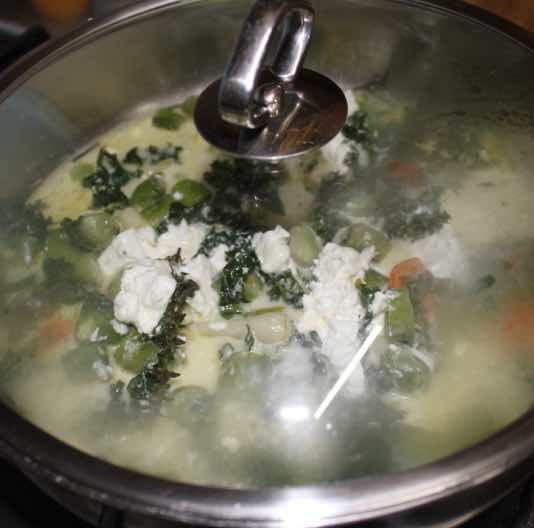
Ingredients
- 2 cups of freshly-podded broad beans.
- 2 cloves of sliced-garlic.
- A few sprigs of thyme.
- Tot of white-wine.
- 100ml fresh cream.
- Handful of chopped young-spinach or kale leaves.
- Optional: a cup of other legumes such as limas or peas; and a herb such as parsley or a slither of a hot-pepper like a jalapeno.
- 2 TBSP of crumbly feta-cheese.
Go for it
- In a medium-sized pot, gently fry the garlic and thyme in butter for a minute or two.
- Add the wine and 2 TBSP of water, bring back to the boil and immediately add the young fava-beans.
- Simmer gently for 3-minutes, then add the cream and other optional ingredients.
- Once the beans are tender, toss in the feta and S&P to season to your taste.
- Serve immediately with any meat dish; we like it with roast-eisbein.
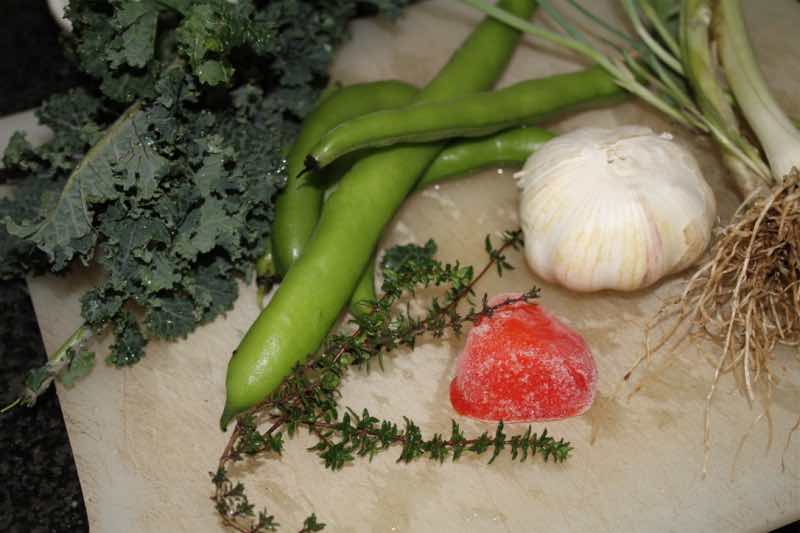
As a variation if you have young, fresh green-pods you can simply slice them like you would a string bean; it is every bit as delicious and research shows there are even more of the nutrients than in the legume itself. Do not even think about trying this if they are old and starchy; perfectly horrid.
One of the reasons we avoided broad beans for many years was that shelling large green-beans was difficult until the good wife figured out how it can be done easily and quickly. It's little tricks like this that eventually convinced us that growing legumes like favas or limas really is worth the effort rather than buying them in cans.
Frankly you will be very lucky to find them at the greengrocer in most countries. In the main you will have to grow them yourself; it is so rewarding. Patience is a virtue.
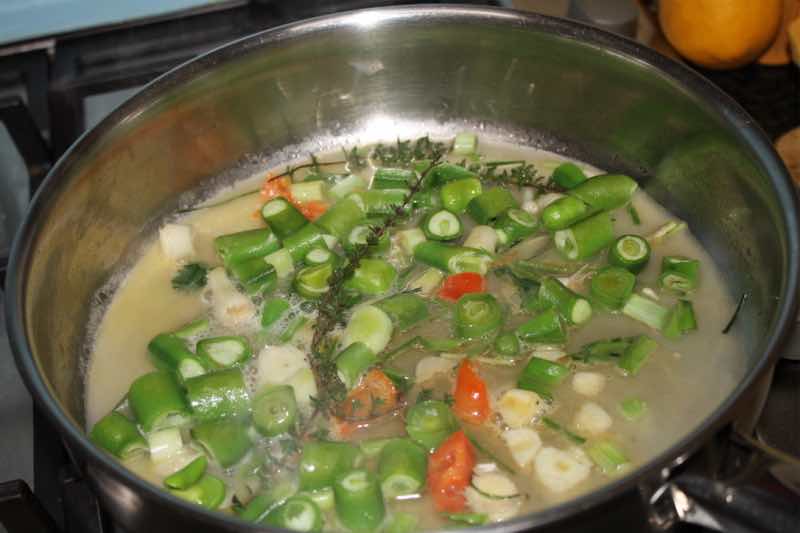
Fava beans with cream and thyme
Fava beans with cream and thyme can provide enough L-dopa for most of those suffering from Parkinson's disease so they do not need medication[2].
I have almost never seen fava-beans at the greengrocer and, if I do, they are invariably old and starchy. This delicious dish is only for those who will take the time to grow them in their own vegetable gardens. It is not difficult; they do need to be staked.
I say not difficult a little too glibly, because shelling large green-beans is something of a trial until you get the knack.
Favas are the richest source of vegetable protein after soyas[1]; about one-quarter of the bean consists of amino acids and the rest is mainly complex carbohydrate which is very slowly digested. They have a low glycemic index, especially when cooked and enjoyed with extra fat such as butter and cream; they will definitely not contribute to your waistline.
The satiety factor is huge; the slow release of glucose means you just do not become famished two-hours later.
They do wonders for the colon where new research shows most of the dopamine in the body is produced; it is being called the second-brain.
Young pods contain even more L-dopa than the bean. Slice a few of them whole in with your fava beans with cream and thyme.
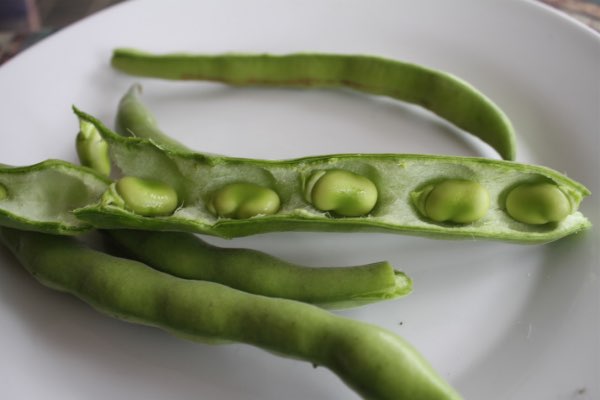
Grow your own fava-beans. In a mild climate plant them in late summer so they can thrive through the cool winter; they will cope with light frost. In the frozen north it is best to sow them in early spring.
Sprout the seeds first between sheets of damp-newspaper before planting.
How to plant broad beans is not rocket-science; they do need to be staked.
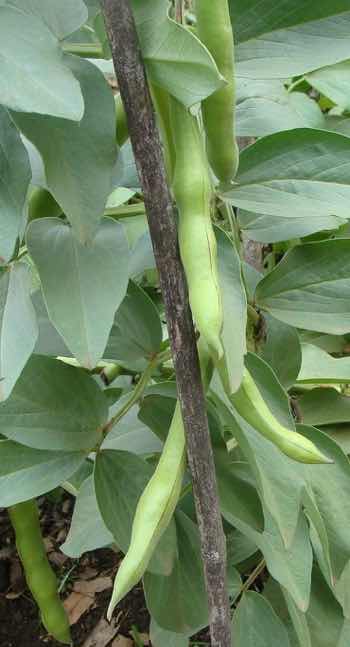
Fresh thyme
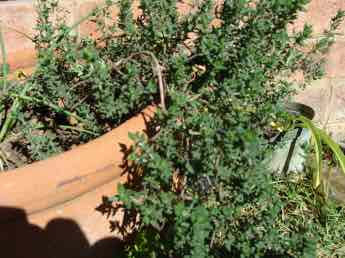
Thyme is such a rewarding and easy herb to grow; every home should have a pot located in full-sun near the kitchen. Snip the sprigs off with scissors.
Thyme herb-benefits are for all.
Butter and cream are back
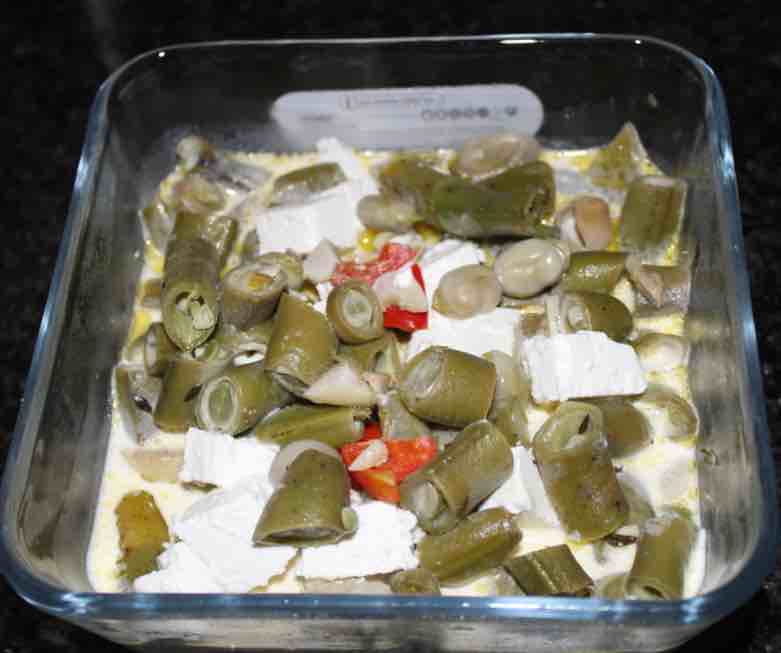
Firstly research shows that there is definitely no advantage in changing from butter to margarine for your cholesterol-profile.
And secondly those eating foods such as fava-beans and spinach, with herbs like thyme and garlic regularly, need have no fear of the cholesterol lurgy.They are a good source of minerals, in particular magnesium for the heart.
Provided we are getting a substantial proportion of our protein from legumes and regularly eat those dishes known as functional foods that promote well-being and prevent disease, we can enjoy our dairy without guilt.
Top 7 functional foods for your well-being are my best picks; every one serious about staying off pills and away from doctors has their favourites.
Butter is back as the saying goes.
Of course we do recommend using olive-oil instead of butter where possible; it can be substituted in this fava beans with cream and thyme dish too.
Beyssara
Beans for breakfast may seem very odd in our Western culture where very questionable refined-cereals, bacon and egg are the norm.
However in many other cultures, dishes such as beyssara which is a
favourite in Morocco, are very common. Unless skinned the glycemic response to fava beans need not concern you.
The great advantage is the satiety factor they provide; legumes keep the wolf from the door at 11am when many Westerners are reaching for a candy-bar, cola or cup of coffee.
Beyssara made with fresh fava-beans is a cinch; personally I'm not fond of those that are dried.
One could enjoy it with whole-grain toast or even on the side with Eggs Florentine, poached on a bed of spinach. Ultimately we have to accept though that whole foods are chewy.
Nutritionally the aim is to get away from those refined cereals, and to keep bacon for high and holy days; processed meat is not the best, even if traditional in an English breakfast.
Ingredients
- 1 cup of young green fava-beans
- Olive oil
- 1 clove of garlic
- 1 tsp cumin
- Half a peppadew or jalapeno
- S&P to taste
Go for it
- Gently fry the garlic, cumin and peppadew in a tablespoon of olive-oil or butter.
- Toss in the fava-beans and half a cup of water.
- 1/2 tsp salt.
- Simmer and render using a potato-masher.
Enjoy with pan-fried toast made with 100% wholemeal flour and butter.
What is cumin you may be asking; it is so much more tasty freshly-roasted and ground. The scent from the smoke is most divine; don't let it burn.
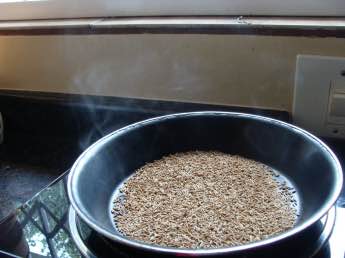
Fava beans nutrition is of the highest-order; any food that helps us escape the neurodegenerative diseases and improves the wellness of our eyes should be on the list of meals enjoyed regularly. And to think that for fifty-years I refused not because of fake news but inadequate understanding. I have a poor memory perhaps as a result.
How I look forward to broad-bean season.
Restless legs syndrome
Restless legs syndrome too is thought to be related to the dopaminergic pathways in the brain; and to an iron deficiency[4]. It is typified by aching and jumpy legs at night, disturbing sleep and causing chronic tiredness during the day. There is an overwhelming feeling of the need to move the lower limbs.
Around one quarter of those suffering from RLS have an iron deficiency anaemia; the move is away from supplements towards eating more foods rich in the element, especially beets.
RLS also affects those suffering from B12 and folate deficiency anaemias; eggs and dark-green leafy vegetables are the solution.
Regular consumption of fava beans would contribute to the dopamine; it binds to the specific receptor in the brain reducing the symptoms.
Walking daily, massage and stretching the legs are all recommended.
SUMMARY
- Walk and stretch the legs daily.
- Eat beets and dark-green leafy vegetables; and eggs.
- Enjoy fava beans with cream and thyme regularly.
When browsing use right click and "Open Link in New Tab" or you may get a bad gateway signal.
Newsletter
Our newsletter is entitled "create a cyan zone" at your home, preserving both yourself and Mother Earth for future generations; and the family too, of course. We promise not to spam you with daily emails promoting various products. You may get an occasional nudge to buy one of my books.
Here are the back issues.
- Lifestyle and ideal body weight
- What are ultra-processed foods?
- Investing in long-term health
- Diseases from plastic exposure
- Intensive lifestyle management for obesity has limited value
- A world largely devoid of Parkinson's Disease
- The impact of friendly bacteria in the tum on the prevention of cancer
- There's a hole in the bucket
- Everyone is talking about weight loss drugs
- Pull the sweet tooth
- If you suffer from heartburn plant a susu
- Refined maize meal and stunting
- Should agriculture and industry get priority for water and electricity?
- Nature is calling
- Mill your own flour
- Bake your own sourdough bread
- Microplastics from our water
- Alternative types of water storage
- Wear your clothes out
- Comfort foods
- Create a bee-friendly environment
- Go to bed slightly hungry
- Keep bees
- Blue zone folk are religious
- Reduce plastic waste
- Family is important
- What can go in compost?
- Grow broad beans for longevity
- Harvest and store sunshine
- Blue zone exercise
- Harvest and store your rainwater
- Create a cyan zone at your home
Did you find this page interesting? How about forwarding it to a friendly book or food junkie? Better still, a social media tick would help.
- Bernard Preston homepage
- Legumes
- Fava Beans With Cream and Thyme
Address:
56 Groenekloof Rd,
Hilton, KZN
South Africa
Website:
https://www.bernard-preston.com